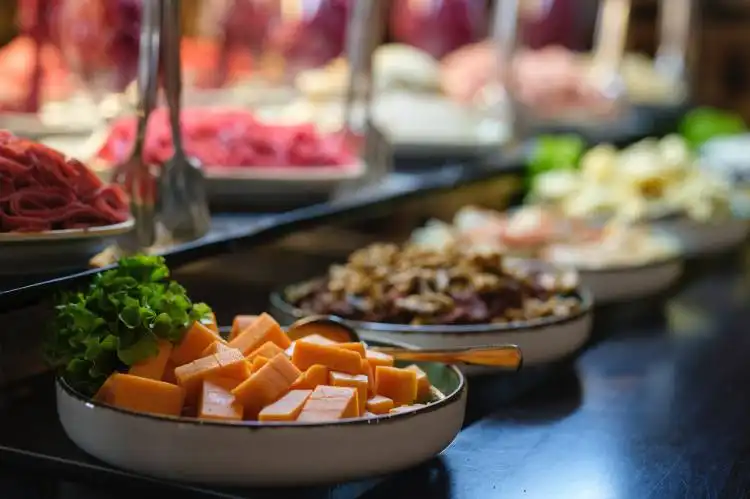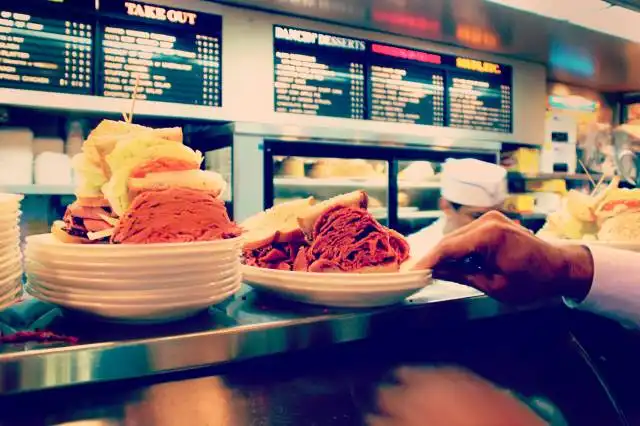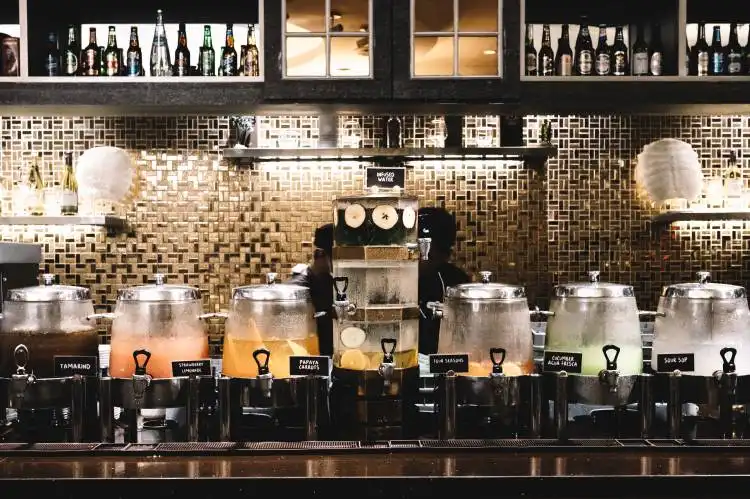Start a Fusion Restaurant
Unleashing Your Inner Culinary Conductor at Your Fusion Restaurant
| Updated


FUSION RESTAURANT
Ready to fuse your love for food and culture into a dynamic business endeavor? Welcome to the world of fusion restaurants! In essence, a fusion restaurant is a culinary gem that mashes up recipes and techniques from multiple ethnicities, offering palettes a cross-cultural plunge into uncharted flavor territories. As the ringleader of this tasty circus, you would not only be dishing up delectable meals, but you'd also cater to the adventurous foodie craving a break from traditional cuisines—exciting, isn't it?
Jump to Business Plan
RELATED BUSINESS IDEAS
Browse ALL Food & Beverage Entrepreneurship Business Ideas
Discover Your Perfect Domain
Unlock the door to your online success with our hand-picked selection of premium domain names. Whether you're starting a new venture or rebranding an existing one, the right domain can set the tone for your digital presence. Browse through our curated list, each with its unique potential to enhance your brand's visibility and credibility.
FUSION RESTAURANT MINI BUSINESS PLAN
This a quick reality check to help you identify the strengths and weaknesses of your business concept before you dive in.
Fusion Restaurant Business: Quick Facts Analysis
Expected Percent Margins:
- Gross Margin: ~70%
- Net Profit Margin: ~6-9%
Earnings Expectations:
- Daily Earnings: Around $800 - $1,500 depending on traffic and location.
- Weekly Earnings: Approximately $5,600 - $10,500.
- Monthly Earnings: Generally in the ballpark of $24,000 - $45,000.
- Annual Earnings: Around $288,000 - $540,000.
Actions to Achieve These Numbers:
- Menu Development: Incorporate diverse and unique fusion dishes that captivate the interest of your target customers. Adjust prices to maintain food cost around 30% of the selling price.
- Location: Selecting the right location greatly influences the success of your restaurant. High foot traffic areas are preferable. Consider the proximity to potential customer sources like offices, shopping centers, or tourist attractions.
- Marketing: Develop a strong marketing plan to induce curiosity about your specialty fusion cuisine. Leverage social media, local newspapers, flyers, etc. Regularly promote the restaurant using special offers or events.
- Workforce: Hiring trained chefs experienced in fusion cooking and attentive waitstaff is crucial. Consider staff costs as approximately 30% of restaurant revenue.
- Inventory Control: Minimize waste by properly organizing and systematically managing your inventory. Use digital systems if feasible.
- Service Quality: High-quality food and excellent service ensure customer loyalty and word-of-mouth promotion.
- Operational Hours: Operate at peak hours to maximize revenue potential; this might include lunch and dinner hours or late-night depending on your customer base.
Note: These are estimated numbers, and can vary greatly depending on various factors such as location, cuisine, competition, market conditions, etc. It's recommended to consult with a restaurant consultant or business advisor for personalized projections.
NOT WHAT YOU HAD IN MIND? Here are more ideas



Browse ALL Food & Beverage Entrepreneurship Business Ideas
Grab Your Business Website Name
Before you get caught up in the whirlwind of setting up your business, invest in a domain name. It's a small but significant step that lays the foundation for your brand and makes it easier for customers to find and trust you. Just like you wouldn't build a house without securing the land first, don't build a business without securing your domain name.
"Why? Can't that wait?" Here's why it shouldn't
Step 1: Determine if Starting a Fusion Restaurant is the Right Endeavor
Breakdown of Startup Expenses
Before starting a fusion restaurant, it is important to understand the startup costs associated with the endeavor. This includes the cost of the space, equipment, furniture, and any other necessary items. It is also important to consider the cost of food, supplies, and ingredients. Additionally, the cost of any necessary licenses and permits should be factored in. Finally, it is important to consider the cost of hiring staff, such as chefs, servers, and dishwashers.
Breakdown of Ongoing Expenses
After the initial startup costs, there are ongoing expenses associated with running a fusion restaurant. These include the cost of food, supplies, and ingredients, as well as the cost of utilities, such as electricity, water, and gas. Additionally, the cost of labor, such as wages for chefs, servers, and dishwashers, should be factored in. Other expenses, such as marketing and advertising, should also be considered.
Examples of Ways to Make Money
There are a variety of ways to make money with a fusion restaurant. This includes charging customers for food and drinks, as well as offering catering services. Additionally, offering take-out and delivery services can be a great way to increase revenue. Additionally, hosting special events, such as cooking classes or private dinners, can be a great way to make money. Finally, offering discounts and promotions can be a great way to attract new customers.
Step 2: Naming the Business
When naming a business, it is important to choose a name that is memorable, easy to pronounce, and reflects the concept of the restaurant. It is also important to make sure that the name is not already in use by another business. To ensure that the name is available, it is important to search the internet, check with the local chamber of commerce, and even search the US Patent and Trademark Office. Additionally, it is important to make sure that the name is not too similar to another business, as this could lead to legal issues.
When choosing a name, it is also important to consider the target audience and the type of restaurant. For example, a fusion restaurant that serves both Asian and Latin American cuisine could have a name that reflects both cultures, such as “Fusion of the Americas.” Additionally, it is important to consider the potential for branding and marketing. A catchy name can help draw attention and make the restaurant more memorable.
Finally, it is important to consider the potential for a website or social media presence. A website or social media page can help to spread the word about the restaurant, so it is important to choose a name that is easy to remember and spell. Additionally, it is important to make sure that the domain name and social media handles are available.
Step 3: Finding a Location
Finding the right location for a fusion restaurant is essential for success. The location should be in an area with a high concentration of people who are likely to be interested in the restaurant's offerings. Additionally, the location should be easily accessible and have ample parking. It should also be in an area with a good reputation and a good mix of other restaurants and businesses.
When considering a location, it is important to research the local zoning laws and regulations to ensure that the restaurant will be in compliance with all applicable laws. Additionally, the restaurant should be located in an area that has the necessary infrastructure, such as water and sewer lines, to support the business.
The restaurant should also be located in an area that has a good mix of residential and commercial properties. This will ensure that the restaurant will have a steady stream of customers throughout the day. Additionally, the restaurant should be located near other businesses that can help to promote the restaurant, such as grocery stores, banks, and other restaurants.
Finally, the restaurant should be located in an area that is safe and secure. This will help to ensure that customers feel comfortable and secure when dining at the restaurant. Additionally, it will help to ensure that the restaurant is able to attract and retain customers.
Step 4: Obtaining Licenses and Permits
Before opening a fusion restaurant, it is important to obtain the necessary licenses and permits from local, state, and federal government agencies. Depending on the location, a restaurant may need to obtain a business license, a food service license, a health permit, a liquor license, and a zoning permit. It is important to research the specific requirements for the area in which the restaurant will be located. Additionally, it is important to understand the timeline for obtaining the necessary permits and licenses. Some permits and licenses may take weeks or months to obtain, so it is important to plan accordingly.
Cost of Obtaining Licenses and Permits
The cost of obtaining the necessary licenses and permits will vary depending on the location and the type of permits and licenses needed. Generally, the cost of obtaining a business license will range from $50 to $200, while the cost of obtaining a liquor license can range from $100 to $1,000. Additionally, the cost of obtaining a health permit can range from $50 to $500, and the cost of obtaining a zoning permit can range from $50 to $500. It is important to research the specific costs for the area in which the restaurant will be located.
Professional Assistance
It is important to note that obtaining the necessary licenses and permits can be a complex process. Therefore, it may be beneficial to hire a professional to help with the process. A professional can provide guidance on the types of permits and licenses needed and can help with the paperwork and filing. Additionally, a professional can provide advice on the timeline for obtaining the necessary permits and licenses.
Step 5: Designing the Restaurant
When designing a fusion restaurant, it is important to create an atmosphere that is inviting and comfortable for customers. The restaurant should be designed to reflect the fusion cuisine and the culture that the restaurant is representing. It is also important to consider the layout of the restaurant and how it will affect the flow of customers. Additionally, the restaurant should be designed to maximize efficiency and minimize wait times.
When designing the restaurant, it is important to consider the colors, textures, and materials used in the design. The colors should be chosen to reflect the cuisine and the culture of the restaurant. The textures and materials should be chosen to create a comfortable atmosphere for customers. Additionally, the restaurant should be designed to maximize efficiency and minimize wait times.
The restaurant should also be designed to accommodate different types of customers. For example, the restaurant should have seating for large groups, as well as smaller tables for couples or individuals. Additionally, the restaurant should have a bar area for customers who want to enjoy a drink while they wait for their meal.
The restaurant should also be designed to accommodate different types of cuisine. For example, the kitchen should be designed to accommodate different types of cooking techniques, such as grilling, steaming, and baking. Additionally, the restaurant should have a variety of dishes that reflect the different types of cuisine.
Finally, the restaurant should be designed to accommodate different types of events. For example, the restaurant should have space for private events, such as birthday parties or corporate events. Additionally, the restaurant should have a space for live music or other entertainment.
Step 6: Hiring Employees
When it comes to hiring employees, it is important to find the right people who are passionate about the restaurant and its mission. It is also important to make sure that the employees have the necessary skills and qualifications to do the job. When interviewing potential employees, it is important to ask questions that will help you determine if the person is a good fit for the job. Additionally, it is important to make sure that the employees understand the restaurant’s mission and vision.
Training Employees
Once the right employees have been hired, it is important to provide them with the necessary training. This should include training on the restaurant’s menu, customer service, and safety protocols. Additionally, it is important to provide employees with the proper tools and resources to do their job. This may include providing them with uniforms, menus, and a copy of the restaurant’s policies and procedures.
Establishing Employee Policies
It is important to establish policies and procedures for employees to follow. This should include policies on customer service, safety, and other operational procedures. Additionally, it is important to establish a system of rewards and punishments for employees who follow or break the rules. This will help to ensure that employees are held accountable for their actions and that they are motivated to do their best work.
Creating a Positive Work Environment
Creating a positive work environment is essential for the success of the restaurant. This includes creating a culture of respect, appreciation, and collaboration. Additionally, it is important to provide employees with the necessary tools and resources to do their job. This may include providing them with the necessary training, tools, and resources to do their job. Additionally, it is important to provide employees with a safe and comfortable work environment. This may include providing employees with ergonomic furniture, proper lighting, and a clean and organized workspace.
Step 7: Creating a Menu
Creating a menu for a fusion restaurant can be a daunting task. It is important to think about the different flavors, textures, and ingredients that will be used in the dishes. It is also important to consider the dietary needs of customers, such as vegetarian and vegan options. Additionally, it is important to consider the cost of ingredients and the time it takes to prepare each dish. To create a menu, it is helpful to research different fusion cuisine recipes, and to experiment with different flavors and ingredients. It is also important to consider the presentation of the dishes, as this can be a major factor in the success of the restaurant.
Creating a Pricing Strategy
Once the menu has been created, it is important to create a pricing strategy. It is important to consider the cost of ingredients, the time it takes to prepare each dish, and the local market prices. Additionally, it is important to consider the cost of labor, as this can have a major impact on the pricing of the dishes. It is also important to consider the profit margin that the restaurant wants to make. Once the pricing has been determined, it is important to adjust the menu items as needed in order to maximize profits.
Testing the Menu
Once the menu and pricing have been determined, it is important to test the menu. This can be done by having friends and family try the dishes, or by having a soft opening of the restaurant. During the testing phase, it is important to pay attention to customer feedback and make adjustments to the menu as needed. Additionally, it is important to test the pricing to make sure that the restaurant is making a profit. Once the menu has been tested and adjusted as needed, the restaurant can be opened to the public.
Step 8: Marketing the Restaurant
Marketing the restaurant is essential to ensure that customers know about the restaurant and are interested in trying it out. There are a variety of ways to market a restaurant, including online advertising, print advertising, word-of-mouth, and social media. It is important to create a plan that outlines the strategies that will be used to promote the restaurant. This should include budgeting for marketing, creating a website, and setting up social media accounts. Additionally, it is important to create a unique brand identity and to use creative tactics to stand out from the competition.
Examples of Creative Marketing Tactics
Creative marketing tactics can help to make the restaurant stand out from the competition. Examples of creative marketing tactics include offering discounts or loyalty programs, creating unique and eye-catching signage, hosting events, and partnering with local businesses. Additionally, offering unique menu items or specials can help to draw in customers. It is important to think outside the box and come up with creative ideas that will help to draw in customers and make the restaurant stand out.
Step 9: Opening the Restaurant
Opening a restaurant is a big undertaking and requires a lot of planning and preparation. It is important to have a plan for the grand opening and to make sure that all of the necessary steps are taken in order to ensure a successful opening. Here are some tips on opening a restaurant:
Make sure to have a grand opening. This should include inviting friends, family, and other important people in the community. This is a great way to get the word out about the restaurant and to show off the hard work that has gone into it.
Have a plan for the day of the opening. This should include having staff ready to serve customers, having the restaurant clean and organized, and making sure that all of the necessary supplies are on hand.
Have a marketing plan in place. This should include advertising the restaurant in the local area, creating a website and social media accounts, and creating promotional materials such as flyers and business cards.
Make sure to have a plan for the first few weeks of the restaurant being open. This should include having staff members available to help customers, having a plan for dealing with customer complaints, and having a plan for dealing with any unexpected issues that may arise.
Have a plan for the long-term success of the restaurant. This should include having a plan for menu changes, having a plan for dealing with customer feedback, and having a plan for expanding the restaurant in the future.
EXPLORE MORE CATEGORIES
Browse ALL Business Idea Categories
TAKE THE NEXT STEPS










